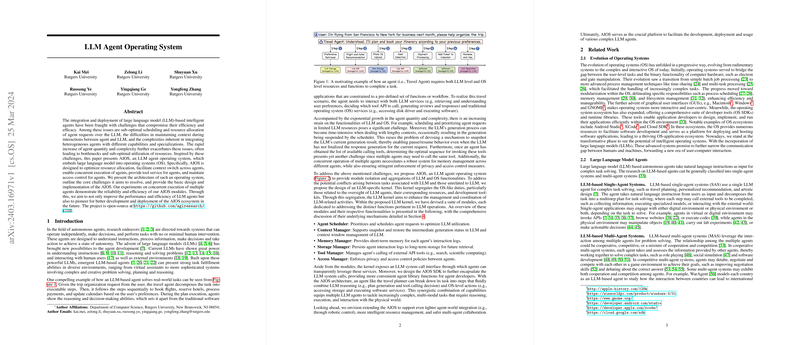Integrating LLMs into Operating Systems with AIOS
Overview of AIOS
The deployment and scaling of LLM-based intelligent agents within existing operating system (OS) frameworks present significant challenges, including inefficient scheduling, complex integration of heterogeneous agents, and sub-optimal resource allocation. The "LLM Agent Operating System" (AIOS) paper presents a novel approach to embedding LLMs into operating systems to address these issues. AIOS optimizes resource allocation, enables concurrent execution of agents, facilitates context switching, and provides essential tool services for agents, thereby improving both the performance and the efficiency of LLM agents.
AIOS Architecture
AIOS is structured into three distinctive layers: application, kernel, and hardware layers, each serving a specific function in the overall system. The application layer hosts the agent applications and leverages the AIOS SDK for development. The kernel layer, consisting of OS Kernel and LLM Kernel, orchestrates the scheduling, context management, memory management, tool management, and access control functions specific to LLM operations. The hardware layer provides the fundamental computing resources but is interacted with indirectly through the system calls to ensure security and abstraction.
Core Modules and Functionalities
The heart of AIOS lies in its LLM Kernel, which harbors several crucial modules:
- Agent Scheduler: Implements scheduling algorithms to optimize LLM utilization and balance agent request processing.
- Context Manager: Supports intermediate generation status snapshotting and context window management, enabling paused responses to be continued.
- Memory and Storage Managers: Provide short-term and long-term data management solutions for handling interaction logs and agent data.
- Tool Manager: Manages a suite of external API tools that agents can call for performing specific tasks.
- Access Manager: Enforces privacy policies and access control measures to maintain data integrity and confidentiality within the multi-agent system.
LLM System Calls and AIOS SDK
AIOS introduces LLM system calls, which serve as intermediary functions facilitating the interaction between agent requests and the execution of kernel modules. To simplify development within AIOS, an SDK is provided, encapsulating these system calls and offering a higher abstraction level for agent developers. This SDK streamlines the creation, deployment, and management of LLM-based agents.
Evaluation and Results
The paper's evaluation of AIOS focuses on the consistency of agent outputs after temporary suspension and the performance of its scheduling mechanism. Utilizing BLEU and BERT scores for consistency measurement, and employing waiting and turnaround time as metrics for scheduling performance, the results substantiate AIOS's ability to maintain output consistency across multi-agent operations and demonstrate its scheduling algorithm's effectiveness in optimizing resource utilization and reducing processing delays.
Implications and Future Directions
The introduction of AIOS pioneers an advanced platform for the integration and efficient management of LLM-based agents within OS frameworks. Beyond immediate performance improvements, AIOS opens pathways for further research, including advanced scheduling algorithms, enhancements in memory and storage architectures, and robust safety and privacy enhancements. These future directions promise to elevate the capabilities of AIOS, driving forward the development and widespread application of intelligent agents across various domains.
AIOS not only addresses existing challenges in deploying LLM agents but also sets a precedent for future research and development in the convergence of artificial intelligence and operating system design. Through its holistic architecture and modular design, AIOS facilitates the scalable, secure, and efficient deployment of LLM agents, marking a significant stride towards realizing the full potential of LLM integration within computing environments.
